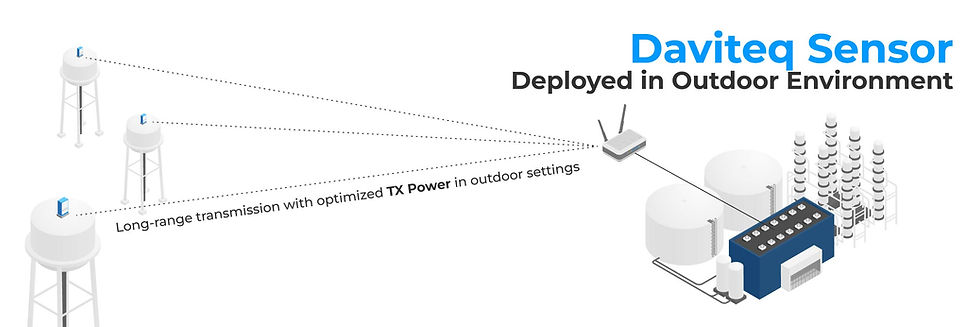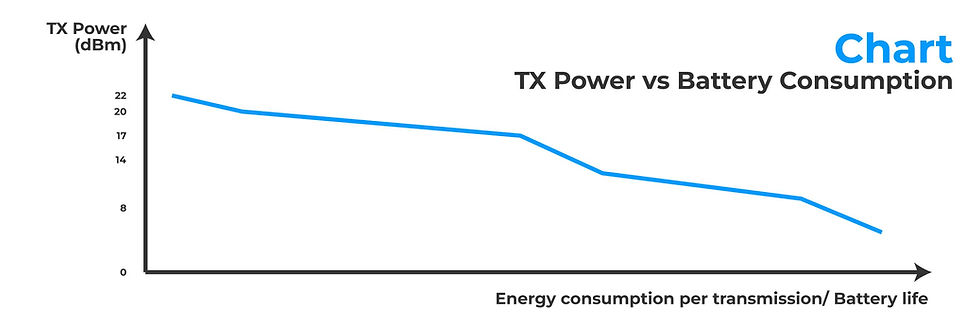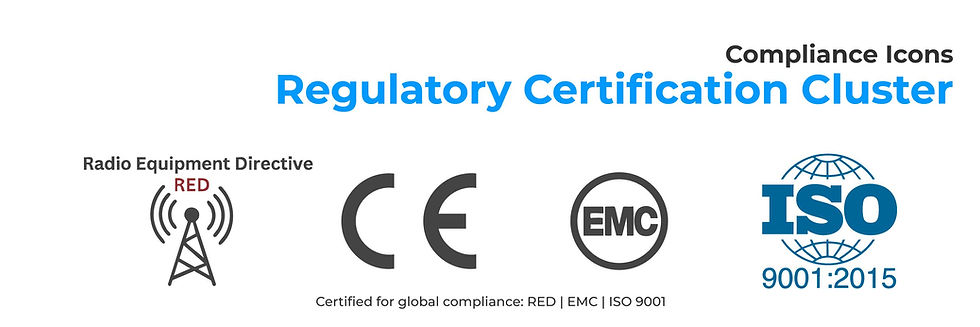TX Power in IoT: How Transmit Power Impacts Sensor Range and Battery Life
- Nguyen Vinh Loc

- Aug 8
- 10 min read
Updated: Aug 19
When deploying an IoT sensor network—whether in a sprawling smart farm, a multi-building factory, or a remote reservoir—there’s one technical parameter that often goes unnoticed but can make or break your system’s performance: TX Power.
Short for transmit power, TX Power determines how far and how reliably your sensor can send data to a gateway. Too low, and the signal may never arrive. Too high, and you risk draining battery life, creating interference, or even violating regulatory limits.
In industrial IoT (IIoT) environments, where sensors must deliver in-time data across harsh or large-scale areas, understanding TX Power is essential. It directly influences coverage range, data reliability, and energy efficiency—three of the most critical factors in any wireless sensor deployment.
In this blog, we’ll break down what TX Power really means, how it behaves in LoRaWAN and other wireless protocols, and why finding the right TX Power setting is a delicate but vital balancing act for your IoT application.
What Is TX Power?
TX Power, or transmit power, refers to the amount of energy used by a wireless device—such as a sensor, gateway, or module—to send a signal over the air. This value is typically expressed in decibel-milliwatts (dBm), a logarithmic unit that helps quantify how strong the transmitted signal is. In simple terms:
TX Power = How loudly your sensor "speaks" to the network.
Just like shouting across a field helps your voice reach further, increasing TX Power allows a sensor’s signal to travel over greater distances or penetrate obstacles such as walls, foliage, or industrial structures. Conversely, reducing TX Power is like whispering—it saves energy, but your message may not be heard unless you're close.

Understanding the dBm Scale
TX Power values in IoT systems usually range from +2 dBm to +22 dBm, depending on:
Here’s a basic guide:
TX Power (dBm) | Signal Strength (Relative) | Typical Use Case |
+2 to +8 dBm | Low to moderate | Short-range, indoor sensors |
+14 dBm | Medium | Standard LoRaWAN node |
+20 to +22 dBm | High | Long-range, outdoor applications |
Note: Each 3 dB increase ≈ doubles the transmit power (but doesn’t double the range linearly).
TX Power vs Signal Quality
Although many people equate strong TX Power with a strong signal, it’s important to understand that transmit power and signal quality are not the same. TX Power refers to the energy a device uses to send data—it’s what the sensor transmits. But that doesn’t guarantee the signal will be received clearly. What truly matters at the receiving end are metrics like RSSI (Received Signal Strength Indicator) and SNR (Signal-to-Noise Ratio), which measure how well the gateway can hear and interpret the signal. Environmental factors like interference, distance, or obstructions can degrade signal quality even if TX Power is set high. In other words, you can shout as loud as you want—but if there’s a wall between you and the listener, your message might still be lost.
This is why TX Power should never be treated as a static value. In modern IoT networks—especially those using LoRaWAN—it’s a dynamic, strategic parameter that must be optimized. Technologies like Adaptive Data Rate (ADR) allow the network to adjust TX Power automatically, based on device location, signal performance history, or battery constraints. In some applications, developers may also configure TX Power manually to strike the right balance between reliability and efficiency.
Set TX Power too low, and you risk packet loss and unreliable data. Push it too high, and you may waste energy, shorten battery life, or even violate local transmission regulations. The goal is to find the sweet spot: just enough power to ensure stable, long-range communication without draining the battery or causing interference. In this sense, TX Power isn’t just a numeric setting—it’s a crucial design decision that directly affects how your entire IoT system performs in the real world.
Why TX Power Matters in IoT and LoRaWAN
In any wireless sensor network, TX Power is more than just a configuration option—it’s a design lever that impacts multiple layers of system performance. From physical coverage to data reliability and energy consumption, transmit power plays a central role in how well your IoT network performs in the real world.
At the most basic level, increasing TX Power expands the communication range. This is critical in environments like industrial zones, farms, or logistics warehouses where sensors may be placed far from the nearest gateway or obstructed by walls, machinery, or terrain. A LoRaWAN® sensor set at +20 dBm can often reach a gateway located several kilometers away in open conditions, while the same device at +14 dBm might only cover half that distance. For outdoor applications or large indoor sites, this extra coverage can mean fewer gateways, less wiring, and lower infrastructure costs.

But range is only part of the equation. Data reliability is equally dependent on the appropriate TX Power setting. A sensor that transmits with too little power may suffer from frequent packet loss, intermittent connectivity, or delayed readings—especially in high-interference or long-range situations. By boosting TX Power within safe limits, you improve the chances of each message being delivered intact and on time, which is essential for time-sensitive applications like process automation, predictive maintenance, or environmental alerts.
However, this improvement comes at a cost. Higher TX Power consumes more energy, and for battery-powered devices—like most LoRaWAN nodes—that can drastically shorten operating life. For instance, increasing TX Power by 3 dB can nearly double the power required per transmission. Over months or years of frequent data reporting, this adds up. In low-power IoT deployments that require devices to last 5–10 years in the field, this becomes a critical design constraint.

Finally, there’s a legal side to consider. Many countries enforce strict regulatory limits on maximum TX Power, especially in sub-GHz frequency bands used by LoRaWAN. Exceeding these thresholds not only risks fines or device certification failures but can also cause interference with neighboring networks. Regions like the U.S. (FCC), EU (ETSI), and Australia (ACMA) all impose specific limits on transmit power output, and any compliant IoT deployment must respect these rules.
In short, TX Power is a balancing act. Too little, and your sensors go silent. Too much, and you drain batteries or violate regulations. But just right—and your IoT network becomes efficient, scalable, and reliable across a wide range of industrial and environmental conditions. That’s why TX Power deserves attention not just from RF engineers, but from anyone designing or deploying wireless sensing systems.
TX Power vs Battery Life
For most industrial and agricultural IoT applications, long battery life isn’t just a nice-to-have—it’s often a hard requirement. Sensors deployed in the field are expected to operate for years without maintenance, especially when they’re installed in remote or hard-to-access locations. And that’s where TX Power becomes a double-edged sword.
While higher TX Power helps ensure a stronger and more reliable connection to the gateway, it also significantly increases energy consumption. The relationship is exponential: for every 3 dB increase in transmit power, the energy required per transmission nearly doubles. That means pushing a sensor from +14 dBm to +20 dBm might improve communication reliability in a noisy or distant environment—but it can also reduce the device’s expected lifetime by several months or even years, depending on how frequently it transmits.

This trade-off forces developers and system integrators to make strategic decisions based on the specific needs of their application. In a factory where devices are close to a central gateway and send data every few minutes, keeping TX Power low conserves battery while still maintaining stable communication. In contrast, a soil moisture sensor in a vast plantation that reports once per hour might justify a higher TX Power setting to overcome distance and terrain—especially if the reporting interval is long enough to offset the added power drain.
What complicates this balance even further is that battery performance isn’t only affected by TX Power. Environmental conditions like temperature extremes, battery chemistry, and hardware sleep modes all play a role. But TX Power remains one of the most controllable levers available to engineers when trying to fine-tune a device’s lifespan.
Fortunately, most LoRaWAN devices—including those from Daviteq—offer flexible ways to adjust TX Power based on deployment conditions. Developers can use adaptive data rate (ADR) mechanisms to let the network optimize power dynamically, or configure TX levels manually during setup to suit static environments. Either way, the key is to avoid overcompensating with brute-force transmission settings and instead aim for the lowest power that still ensures reliable delivery.
In the end, balancing TX Power and battery life is not about choosing one over the other—it’s about designing with purpose. By understanding how even a few dB can shift the performance curve, IoT engineers can make smarter decisions that lead to longer-lasting, more resilient deployments in the real world.
Regulatory Constraints on Transmit Power
While TX Power offers flexibility for improving signal range and communication reliability, it is also subject to strict legal limits in every market where wireless devices operate. Regulatory authorities such as the Federal Communications Commission (FCC) in the United States and the European Telecommunications Standards Institute (ETSI) in the EU enforce transmit power constraints to prevent interference, ensure spectrum efficiency, and protect public safety.
For devices operating in sub-GHz frequency bands—like 433 MHz, 868 MHz, or 915 MHz—these rules specify maximum allowable effective radiated power (ERP) or equivalent isotropic radiated power (EIRP). Wireless transmitters must be tested against these thresholds to confirm they operate safely within licensed spectrum boundaries.
To meet these requirements, Daviteq wireless sensors have undergone independent certification by SGS Taiwan Ltd., with full test reports conforming to ETSI EN 300 220-2 V3.1.1:2017—a core radio standard under the EU RED Directive (2014/53/EU). This confirms that our LoRaWAN®-based and Sub-GHz sensors operate within internationally recognized limits on transmit power output, frequency accuracy, and spurious emissions. Although RED is an EU directive, many global markets—including parts of North America, Oceania, and Southeast Asia—recognize its testing framework as a benchmark for wireless product validation.
In parallel, Daviteq products have also passed testing for EMC (Electromagnetic Compatibility) under Directive 2004/108/EC, certified by EUROCERT. EMC compliance ensures that our transmitters do not interfere with nearby devices or systems and remain resilient to noise from other electronic sources—a critical consideration in industrial and high-density wireless environments.
Underpinning all of this is a robust quality management system. Daviteq is an ISO 9001:2015-certified manufacturer, which guarantees that our design, production, calibration, and verification processes are documented, controlled, and continually improved. This level of quality assurance ensures not only technical performance but also consistent regulatory conformity across product batches and deployments.

In short, TX Power is a regulated parameter, not just a performance knob. Designing wireless IoT systems requires more than technical optimization—it demands legal compliance with spectrum standards and emission limits. With globally recognized certifications in place, Daviteq enables customers to deploy their IoT networks with full confidence that every transmission is powerful, efficient, and legally sound.
How to Optimize TX Power for Your IoT Deployment
Finding the optimal TX Power level isn’t about maximizing range at all costs—it’s about striking the right balance between coverage, reliability, energy consumption, and regulatory compliance. Every IoT deployment is unique, and that means transmit power should be tailored to the physical environment, network topology, and operating constraints of the system.
In high-density environments like smart factories or commercial buildings, where gateways are placed close to sensor clusters, running devices at maximum TX Power is both unnecessary and inefficient. Reducing TX Power in such cases helps extend battery life, reduce interference, and minimize signal collisions. Conversely, in wide-area deployments like agriculture fields, water infrastructure, or remote monitoring stations, higher TX Power may be required to overcome long distances and signal attenuation caused by terrain, foliage, or weather conditions.
The key is to measure before configuring. Using tools like RSSI and SNR data collected during trial runs, developers can assess the minimum TX Power needed for reliable packet delivery. This helps avoid over-provisioning and keeps power budgets under control. Many LoRaWAN® networks support Adaptive Data Rate (ADR), a built-in feature that dynamically adjusts data rate and TX Power based on link quality—reducing overhead for developers while optimizing performance. For static deployments or custom firmware applications, manual TX Power configuration offers finer control, especially when sensors report infrequently or operate under tightly defined constraints.

At Daviteq, our wireless sensors are designed to support flexible TX Power tuning. Depending on the model, users can adjust transmit power remotely through platforms like Globiots, or locally via Modbus RTU configuration tools. This allows system integrators to match each sensor’s TX Power setting with its deployment context—whether that’s a short-range indoor node in a climate-controlled warehouse, or a long-range outdoor sensor exposed to interference and obstacles.
Ultimately, optimizing TX Power isn’t just about improving signal strength—it’s about building resilient, energy-efficient, and regulation-compliant IoT systems that can scale with confidence. With the right data, configuration tools, and deployment strategy, you can get the most out of every transmission—extending battery life, reducing maintenance costs, and ensuring reliable communication across your entire network.
In the design and deployment of wireless IoT systems, TX Power is often underestimated—but never unimportant. From determining how far a sensor can transmit data, to how long it will run on a battery, to whether it complies with regional regulations—transmit power sits at the intersection of performance, reliability, efficiency, and legality.
As we’ve explored throughout this article, optimizing TX Power is not about pushing it to the maximum. Instead, it’s about applying a strategic mindset: understanding your network topology, evaluating signal conditions, and using available tools—like Adaptive Data Rate (ADR), RSSI/SNR diagnostics, or remote configuration platforms—to tune each device to its environment. When done properly, this balance leads to fewer dropped packets, longer device lifespans, and more scalable, resilient systems.
At Daviteq, we design our wireless sensors with this balance in mind. With built-in support for flexible TX Power adjustment, international regulatory compliance, and low-power operation, our solutions empower developers and system integrators to get the most out of their deployments—whether they span meters or miles.
So, whether you're building a smart factory, deploying a precision agriculture system, or connecting assets across a city or country, don’t overlook TX Power. It’s not just a number—it’s a critical tool in building IoT systems that work smarter, last longer, and scale stronger.



Comments